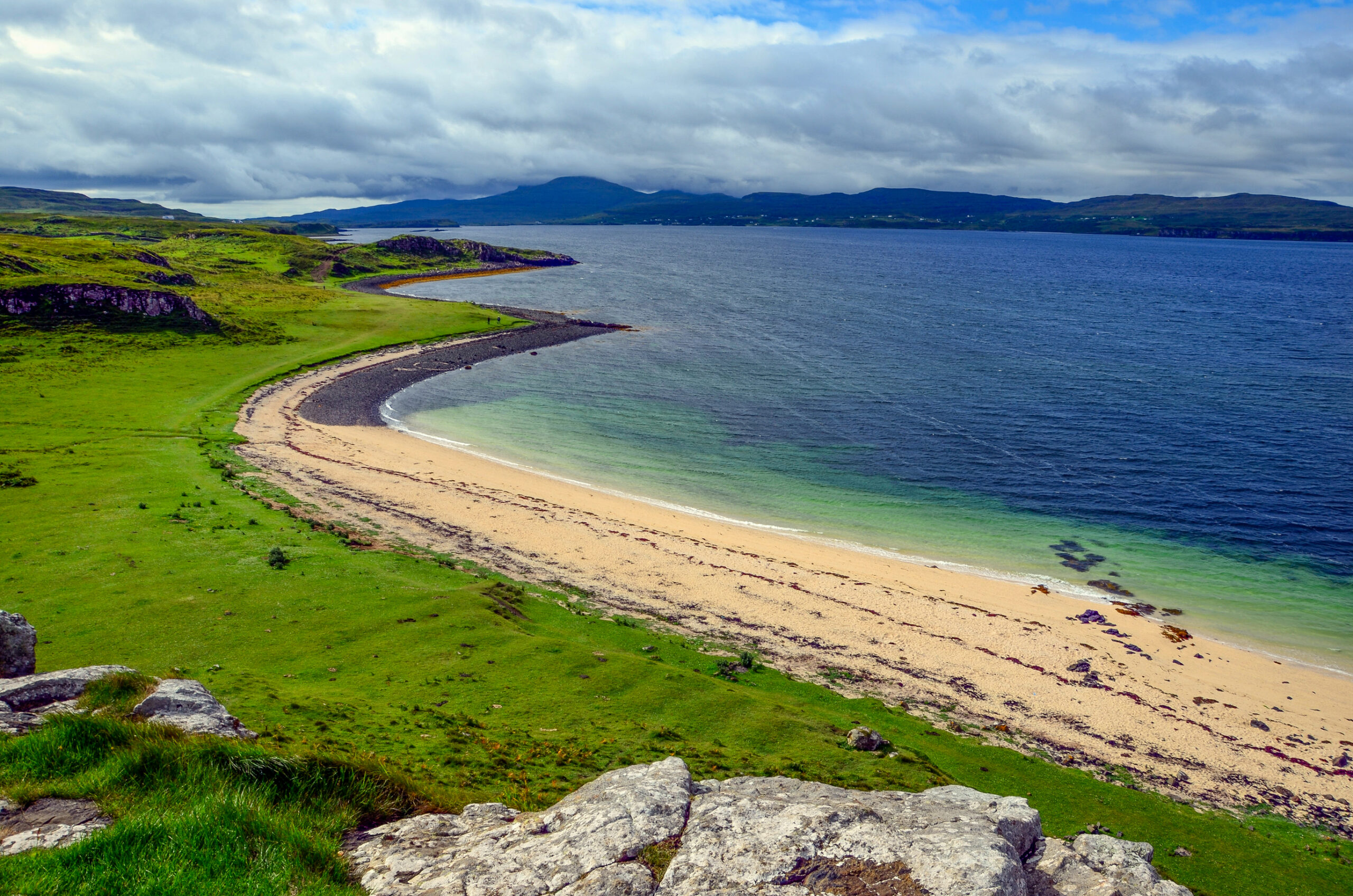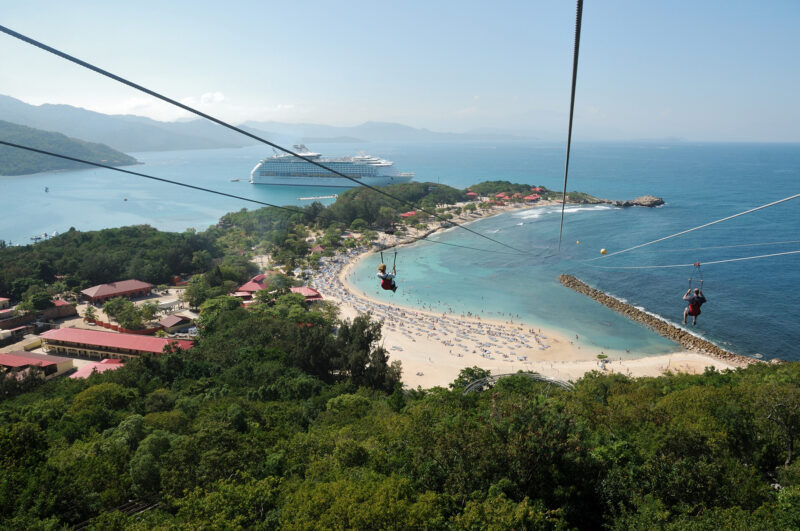Scotland is famous for its dramatic mountain scenery, iconic lochs, and castles, but did you know it has many beaches that resemble those found in the Caribbean? The striking white sands on many Scotland beaches are made up of crushed shells that have accumulated over thousands of years, resulting in the bright, white shade. The color of the sand reflects light, and when combined with clear, shallow water, it creates a vivid blue-green hue similar to the sea that frames Caribbean beaches.
While the water is quite a bit chillier than what you might find in the tropics, during the warmer months of the year, many visit the country’s stunning beaches to enjoy refreshing dips while immersed in a breathtaking scene. You might even find a pop-up sauna at some of them, perfect to warm up in afterward. A swim in the sea followed by time in the sauna, with the cycle repeated a few times, is the perfect way to feel as relaxed as a bowl of Jello.
A visit to any of these Scotland beaches might make you think you’ve accidentally landed in the Caribbean, but the sounds of the bagpipes and the scent of the heather covering the hills will assure you that you’re in bonnie Scotland.
The Singing Sands, Isle of Islay

A small but incredibly picturesque beach, if you walk across Singing Sands with shoes on, it sounds as if it’s singing thanks to the size and shape of the sand granules, the silica it contains, and the level of humidity. The secluded stretch is located behind the Carraig Fhada Lighthouse and boasts crystal-clear turquoise water that laps against the caramel-hued sands, beautifully contrasting against the jagged black rocks rising from the shore. It’s a perfect place for a picnic, birdwatching, or just watching the boats that sail into Port Ellen. Keep an eye out for otters and seals in the bay, as well as the occasional wild goat just south near the lighthouse.
Luskentyre Beach, Isle of Harris

The Outer Hebrides are often referred to as the “Caribbean without the crowds,” and Luskentyre is the archipelago’s crown jewel. Located on the Isle of Harris, it boasts miles of unspoiled white sands and exceptionally clear aquamarine water. TripAdvisor readers once named it among the most beautiful in the UK, with one traveler exclaiming that he’d “never seen anything quite like it.” Despite its acclaim, you can wander for miles at Luskentyre without encountering another soul. You can simply relax and soak up the beauty, but it’s also possible to cycle a three-mile route linking the beach to the island’s main road. When the tide is right, there will be many places to capture photos along the way with the stunning colors of the landscape constantly changing.
Horgabost Beach, Isle of Harris

If you visit Luksentyre, don’t miss Horgabost, just a short drive away, although it attracts even fewer visitors as it’s not as well known. A remote and quiet stretch with soft, ivory sands, it also looks as if it should be on an island in the Caribbean, facing west into the Atlantic between Taransay Island and Toe Head. It shares the same crystal-clear aquamarine water that Luskentyre does, with the mountains beyond creating an awe-inspiring backdrop. In addition to strolling the pristine sands, paddleboarding and kayaking can be enjoyed here. It’s best to bring your own food and drink as there are no facilities right at the beach, but you will find a campsite with toilets and a shop just a stone’s throw away.
If you’re up for an adventure, you might join a boat trip to the island of Taransay, Britain’s largest uninhabited island with 3,800 acres to explore. It’s the perfect place to experience a place that’s truly wild and remote, as well as being the filming site for the BBC’s reality TV series “Castaway 2000.”
Bosta Beach, Great Bernera

Bosta Beach on Great Bernera, connected to the Isle of Lewis by a road bridge, is not only renowned for its stunning Caribbean-like looks with fine white sands and clear, calm cobalt water, but there is also an Iron Age House just steps away. An ancient village was hidden beneath the dunes here until a severe storm exposed its stone walls, revealing a well-preserved settlement with homes dating between 400 and 800 AD. While erosion and sand buildup caused it to crumble, a life-size reconstruction was created at the site based on the original buildings.
In addition to the Iron Age reconstruction, there’s an interesting stone-walled cemetery, and a lush green meadow is dotted with colorful wildflowers where Highland cattle can often be seen roaming, making Bosta a favorite among locals and visitors alike.
Bay of Skaill, Orkney
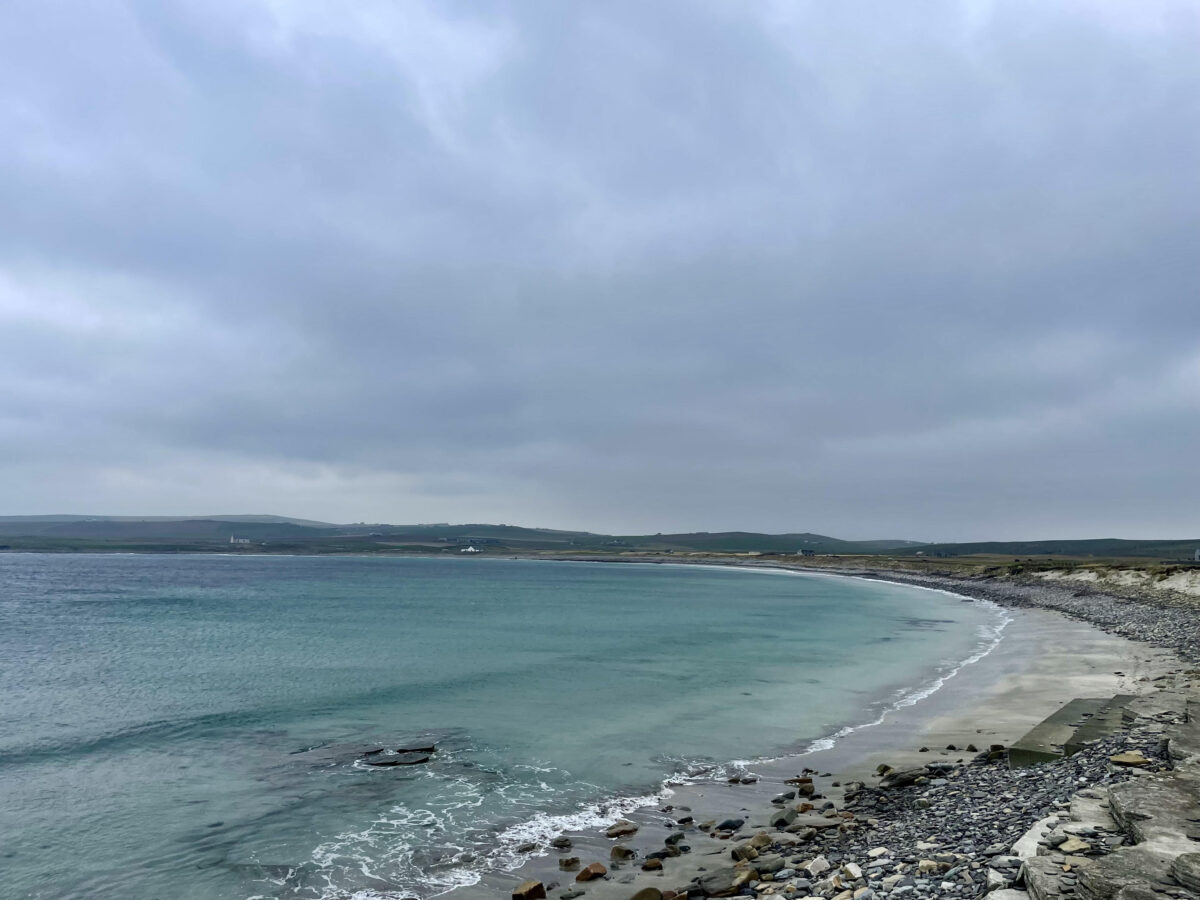
Sometimes simply referred to as the “Skara Brae beach,” as it lies adjacent to the Neolithic settlement of Skara Brae, occupied between 3180 and 2500 BC, the Bay of Skaill is a dramatic stretch of white sands on Orkney Island. It provides a breathtaking contrast to the ancient Stone Age village, the most complete from Neolithic times in all of Europe, with the furnishings and walls all still visible. While the village is the star of the show here, you can’t help but notice the beauty of the beach, and no visit would be complete without walking on its sands. When the tide is out, it seems as if it stretches for miles with dazzling views that curve to the north and south. Watch for the Hole o’Rowe, a hole in the cliffs created by the elements over centuries.
Racwick Beach, Isle of Hoy
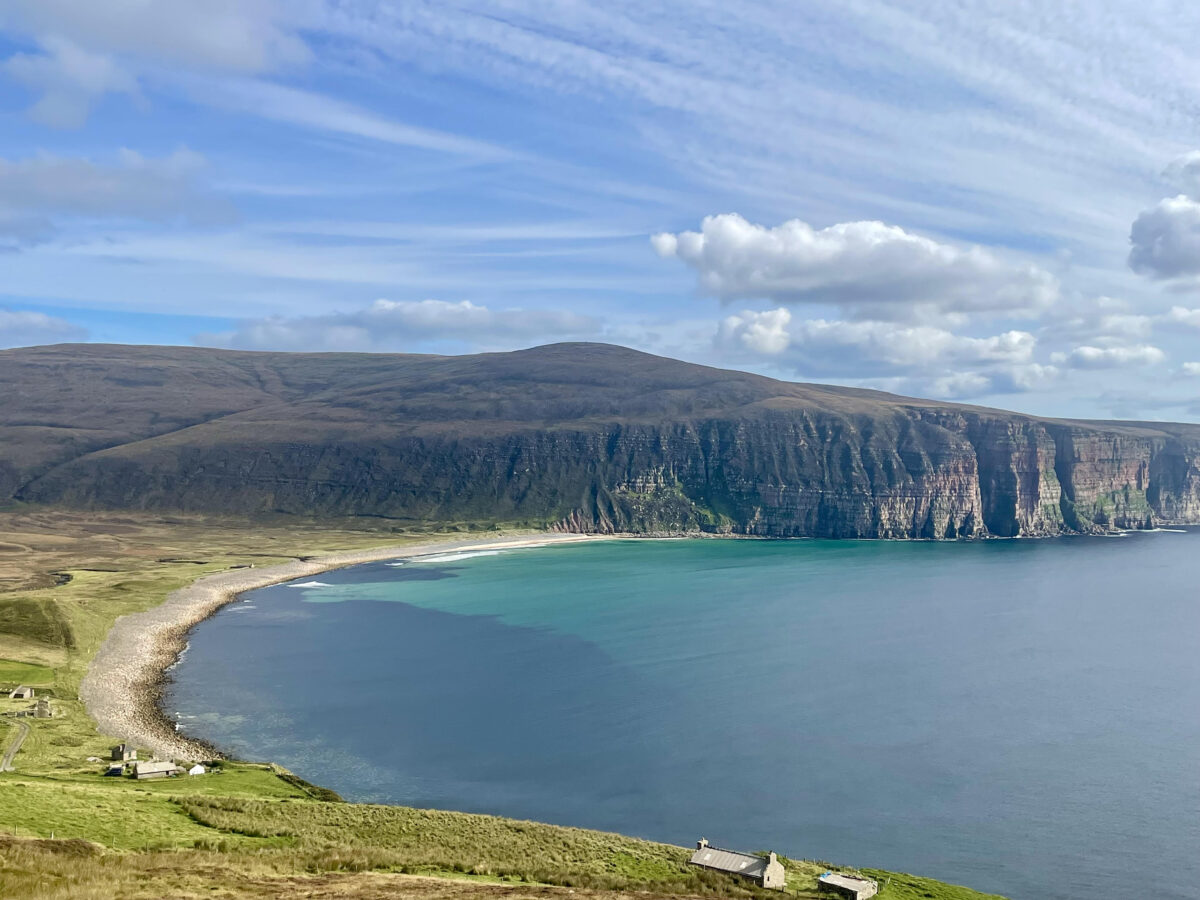
I visited the Isle of Hoy in the Orkney Islands specifically to hike to the iconic Old Man of Hoy, a towering sea stack that lies just off the coast. But at first glimpse of the beach located at the trailhead, I knew it was worth visiting for that alone. Racwick is a stunner, nestled in a valley between high cliffs, with ancient rocks strewn about. One of the most remote Scotland beaches, the drama of the setting is sure to entice, but you’ll get the best view by climbing the trail that provides the most idyllic vantage point. Capture a photo from here and then, after your hike, perhaps bring a picnic to enjoy on the sand while soaking up the incredible scenery.
Cata Sand, Tresness Peninsula, Sanday

Also located in the Orkney Islands, Sanday is a peaceful island filled with chalk-white sand beaches and sweeping, shallow bays, but you won’t find another like Cata on Tresness. This is a thin peninsula made up of dunes that divides the North Sea to the east and a sheltered bay to the west. Cata Sand looks as if it snakes for miles as one of the most breathtaking beaches in the archipelago. At the southern tip of the peninsula, you’ll discover a prehistoric chamber tomb where archaeologists can often be seen digging.
As you explore, you’re likely to see many birds, including Arctic terns that nest here from April through September. Harbour seals can be seen with their pups in June and July, while grey seals have their pups here in October and November. Porpoises, orcas, and occasionally sperm and humpback whales can be seen in the waters around Sanday too.
Coral Beach, Isle of Skye

The Isle of Skye, one of the islands in the Inner Hebrides that’s linked by a bridge to the mainland, has become one of Scotland’s hottest spots for tourists. It’s renowned for its fantasy-like landscapes that include towering sea cliffs where waterfalls cascade into the sapphire sea, “fairy pools,” and dramatic, emerald mountains with otherworldly rock formations. There are also some spectacular beaches, such as Coral Beach, one of Skye’s most unique, with its white crushed coral fragments resulting in a Caribbean-like appearance. It often lands on lists of the world’s most beautiful with surreal blue waters and incredible views across to Loch Dunvegan.
A true gem, the Coral Beach is a local favorite with many other highlights beyond its own beauty, such as the tidal island of Lampay, which visitors can access on foot at low tide and enjoy jaw-dropping views of historic Dunvegan Castle. Plus, while you’re here, you can easily take a tour of the castle gardens and the castle itself, with many treasures like The Fairy Flag of Dunvegan, woven around the 4th century AD as an heirloom of the chiefs of Clan MacLeod.
Silver Sands of Morar, Mallaig

A series of magnificent sandy beaches along the western coast of the mainland between Arisaig and Morar, near the town of Mallaig, where the Jacobite/Harry Potter train turns around, the Silver Sands offers beautiful views of the Small Isles of Canna, Eigg, Rum, and Muck. They can be enjoyed together or individually as a popular place to walk while enjoying the views. It’s also possible to join a sea kayaking tour from the Arisaig Sea Kayaking Centre to explore the bays, or book a guided horseback ride with the Silversands Trekking Center to enjoy the sands from another perspective.
Achmelvich Bay, Lochinver
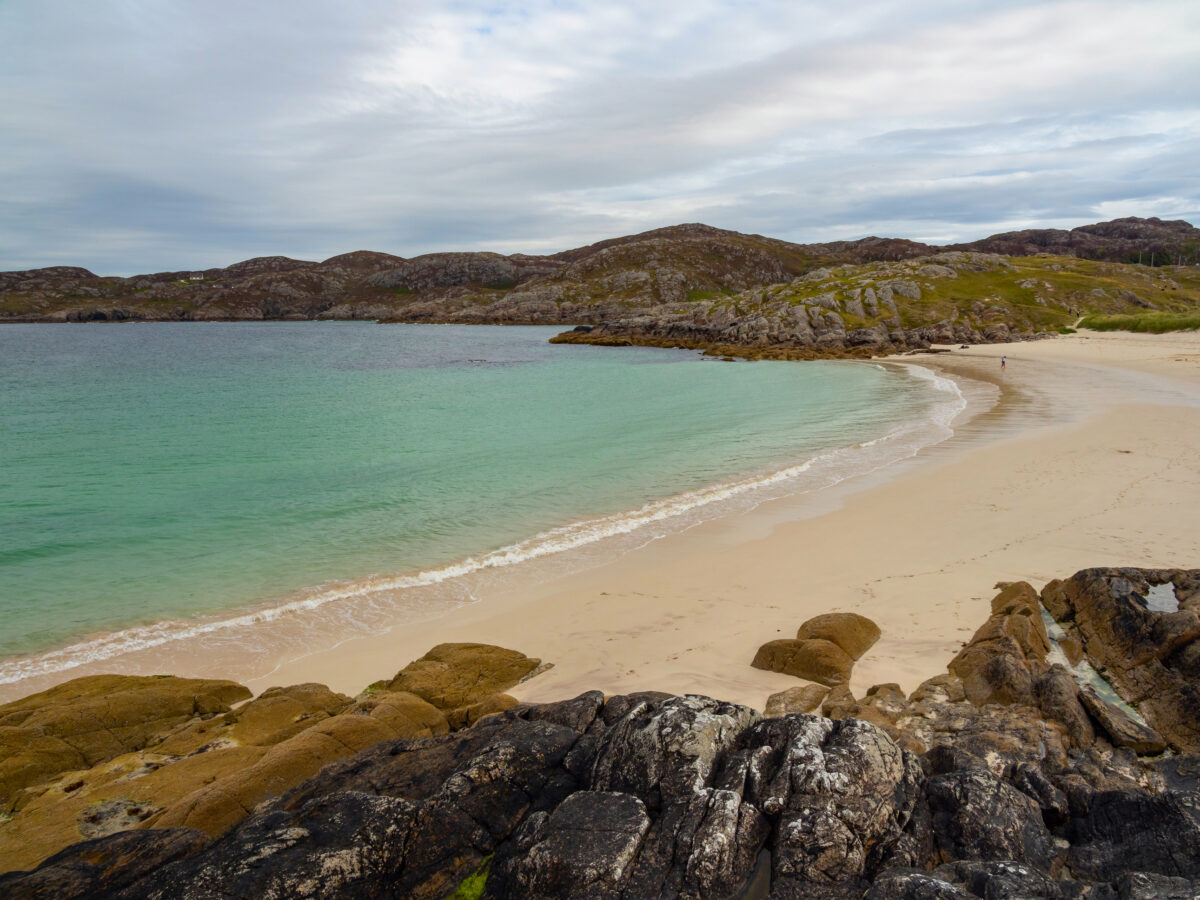
A hidden gem on the northwest coast of the mainland, about three miles from Lochinver village in the Highlands, Achmelvich Bay is a lesser-known beach with breathtaking views. The sea is an even more brilliant blue under sunny skies, while the beach is bright white and sandy. It’s an ideal spot to paddleboard, kayak, water ski, or windsurf. Of course, you can always simply relax and enjoy the feel of the tropics, albeit with chillier temperatures. There are also many scenic hikes nearby, including the famous trek up Suilven, a dramatic mountain that rises from the wilderness. From the summit, you’ll have magnificent views of the surrounding landscape, including lochs and moorlands.

